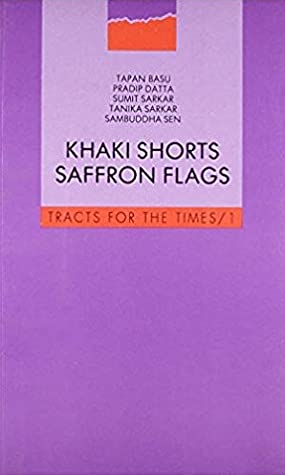

 |

|

The average rating for Know the new right based on 2 reviews is 4 stars.
Review # 1 was written on 2015-01-04 00:00:00 Chaz Rodgers Chaz RodgersShort book on the history of the VHP and RSS, and how they engage the masses through media. the authors are clearly coming from a non hindutva position, wherein most of the core claims of hindutva are not taken seriously. This is for the most part, normal and acceptable, but in some cases it makes the piece sound biased, especially in regards to the historical role of Islam as a force for violence in the subcontinent. It portrays these organizations as modern, strange phenomena on the crossroads of religion and politics. It portrays them as extremely deceptive and manipulative, and shows some good reasons for that portrayal. These groups are very willing to compromise with authority just after battling against it, unlike actually revolutionary groups. They are willing to fabricate history, and engage in fairly blatant media manipulation. They are basically scheisty authoritarians who wish that they had the power which congress has historically maintained. Just another political party, but one which has the advantage of appealing to deeply held and irrational commitments of Hindus. Essentially, if you buy this books premise, these groups are not bulwarks of defense of Hinduism. They seek to manipulate and use Hinduism in order to gain political power, and in the process, to transform Hinduism Into a monolithic and conservative ideology which contains a political ideology, and which is represented by the VHP and Rss. This book fairly dated at this point, so it'll only be useful if you are interested in the early years of these organizations and the events preceding babri masjid. |
Review # 2 was written on 2020-04-08 00:00:00 Ross Waldner Ross WaldnerKhaki Shorts, Saffron Flags In 2014, when the wave of Hindutva hit electoral politics in India, I had read this book. I decided to read the book for the second time because I feel it is imperative to keep oneself abreast of the historiography of Hindutva politics, especially when it is in power. As an ideology, Hindutva sustains itself through the use of stereotypes and symbols. There is no ambiguity in its political endeavour. The sole goal of Hindutva is 'Hindu Rashtra', where 'Rashtra' stands for the nation, quite different from the State, as it denotes a cultural paradigm consisting of the community that resides in its demography. However, there have always been two parallel strands within Hindutva. On the one hand, we have a moderate approach, while the other depicts the more radical side of it. In the case of the Ram Janmabhoomi Movement, Advani represents the moderate aspect; Uma Bharati is the extreme face of the movement. In the present central government, Modi is the moderate one, whereas Amit Shah the more radical. However, there exists no conflict of interest between these two strands. They are mutually inclusive of each other, maintaining the symmetrical balance in Hindutva politics. An equally intriguing example of these twin images can be found when one studies Ram'the archetypal hero of the Hindu Rashtra. Ram is the figure who has faced many losses'he lost his kingdom, his home, his wife. At the same time, he is also the figure who emerges victorious against the devil Ravan. He is at once the 'Ramlalla', seated in the demolished Babri Masjid as well as the ferocious male deity who walks through the inferno to taste the milk of paradise. Similarly, we have the Vishwa Hindu Parisad, established in 1964 by Golwarkar comprising mainly 'sadhus', and we also have the Bajrang Dal, an organisation that recruits unrestrained, lumpen youths to unleash a reign of terror during communal riots. What is equally problematic is the fact that RSS-VHP-BJP is an exclusive men's organisation. It does not engage with issues concerning social inequality and exploitation. It does not have an adequate theory of capitalism nor does it provides a critique of it. Hence, more than the Muslims, socialists are Hindutva's more hardened enemies. Also, RSS tries to hide the reason behind its establishment. In 1925, RSS was formed to challenge the growing caste consciousness among Dalits in Maharastra, a movement led by Jyotiba Phule. No wonder RSS has never engaged with Dalit politics in India; instead considers the Manusmriti as one of the central text that helps propagate its ideas. Hindutva rests on a monolithic understanding of Hinduism. It does not encourage difference and dissent. For anyone who wants to learn about the origin and growth of Hindutva in South Asia, the book will come in handy as it provides a brilliant introduction to its political philosophy. |
CAN'T FIND WHAT YOU'RE LOOKING FOR? CLICK HERE!!!